Potřebujeme váš souhlas k využití jednotlivých dat, aby se vám mimo jiné mohly ukazovat informace týkající se vašich zájmů. Souhlas udělíte kliknutím na tlačítko „OK“.
ASTM D6476-12
Standard Test Method for Determining Dynamic Air Permeability of Inflatable Restraint Fabrics
Automaticky přeložený název:
Standardní zkušební metoda pro stanovení dynamické průvzdušnosti nafukovací ochranné tkaniny
NORMA vydána dne 1.7.2012
Informace o normě:
Označení normy: ASTM D6476-12
Poznámka: NEPLATNÁ
Datum vydání normy: 1.7.2012
Kód zboží: NS-35287
Počet stran: 6
Přibližná hmotnost: 18 g (0.04 liber)
Země: Americká technická norma
Kategorie: Technické normy ASTM
Kategorie - podobné normy:
Karosérie a součásti karosérie silničních vozidel
Textilní tkaniny
Anotace textu normy ASTM D6476-12 :
Keywords:
airbag, inflatable restraint, permeability, ICS Number Code 43.040.60 (Bodies and body components), 59.080.30 (Textile fabrics)
Doplňující informace
| Significance and Use | ||||||||||||
|
For matters relating to lot acceptance of commercial shipments and conformity to specification or other standard, refer to Section 13 of this test method. This test method is useful in the selection and design validation of permeable, uncoatable fabrics used in inflatable restraint cushions. The dynamic conditions and higher pressure differentials of this test method may better simulate the inflation and deflation cycle of an airbag module during deployment than do the steady-state conditions of Test Method D737. 5.2.1 Only uncoated, permeable fabrics should be used. Use of coated fabrics may yield invalid results and potentially damage the test apparatus. Within the limits of variance expressed in Section 12, this test method is useful for design validation and may be suitable for incorporation in a material specification or for lot acceptance testing of commercial shipments. Caution is advised on very low permeability fabrics or with the 200 cm3. size test heat because between-laboratory precision as presented in Section 12 may be as high as 21 %. This test method may be used for materials other than inflatable restraint fabrics which experience dynamic air permeability in sudden bursts. In such cases, the physical apparatus or its software algorithms may require modification to provide suitability for use. Due to the split-second time interval for testing, the pressure versus time data is subject to recording anomalies and electronic noise. The data should be digitally filtered to obtain the underlying smooth pressure curve prior to data analysis. The software in the apparatus includes a reliable algorithm both to smooth the curve and to determine the exponent of air permeability. It is inherent in the design and operation of this equipment that major components key to the calibration and measurements are specific to the individual test head. The size or permeability measuring range of the test head is typically chosen to correspond to the fabric specimen to be tested. The precision of this test method is highly dependent on the size of the test head. The precision of the data collected using one test head should be used to estimate the precision of data collected using a different test head, even on the same apparatus. It is mandatory that fabric specimens be conditioned and tested in standard atmosphere for testing textiles. |
||||||||||||
| 1. Scope | ||||||||||||
|
1.1 This test method covers the procedures used to determine under dynamic airflow conditions the high pressure permeability of permeable, uncoated fabrics typically used for inflatable restraints. For the determination of air permeability of inflatable restraint fabrics under low pressure conditions at steady-state air flow, refer to Test Method D737. 1.2 Procedures and apparatus other than those stated in this test method may be used by agreement of purchaser and supplier with the specific deviations from the standard acknowledged in the report. 1.3 The values stated in SI units are to be regarded as standard. No other units of measurement are included in this standard. 1.4 This standard does not purport to address all of the safety concerns, if any, associated with its use. It is the responsibility of the user of this standard to establish appropriate safety and health practices and determine the applicability of regulatory limitations prior to use. |
||||||||||||
| 2. Referenced Documents | ||||||||||||
|
Podobné normy:
Historická
1.2.2011
Historická
1.7.2013
Historická
1.6.2011
Historická
1.7.2014
Historická
1.7.2012
Historická
1.11.2011


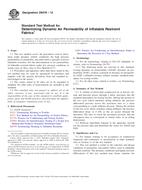
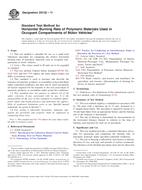 ASTM D5132-11
ASTM D5132-11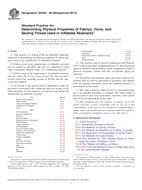 ASTM D5446-08(2013)..
ASTM D5446-08(2013)..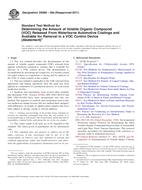 ASTM D6266-00a(2011)..
ASTM D6266-00a(2011)..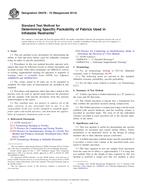 ASTM D6478-10(2014)..
ASTM D6478-10(2014)..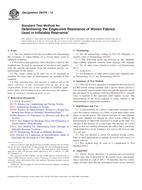 ASTM D6479-12
ASTM D6479-12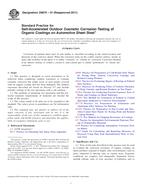 ASTM D6675-01(2011)..
ASTM D6675-01(2011)..
 Cookies
Cookies
